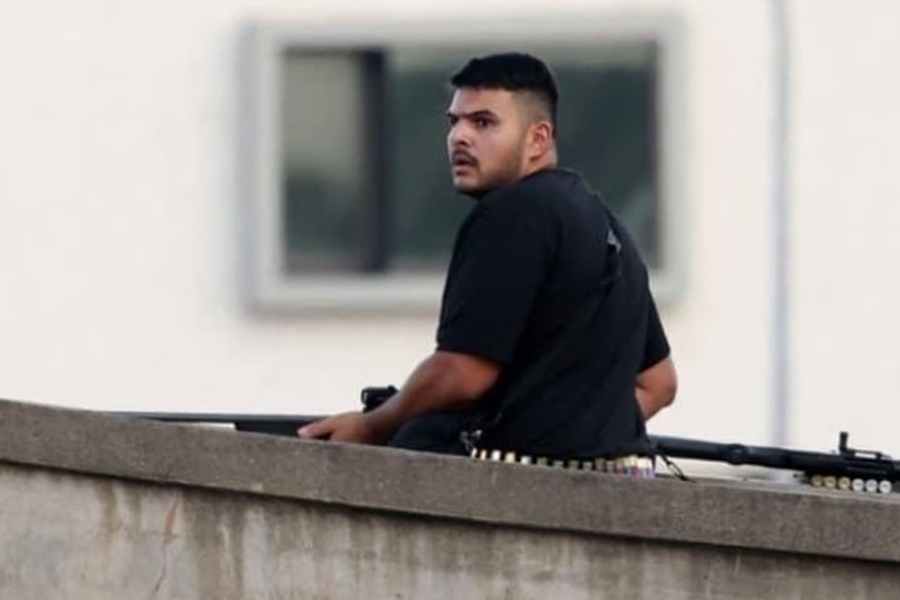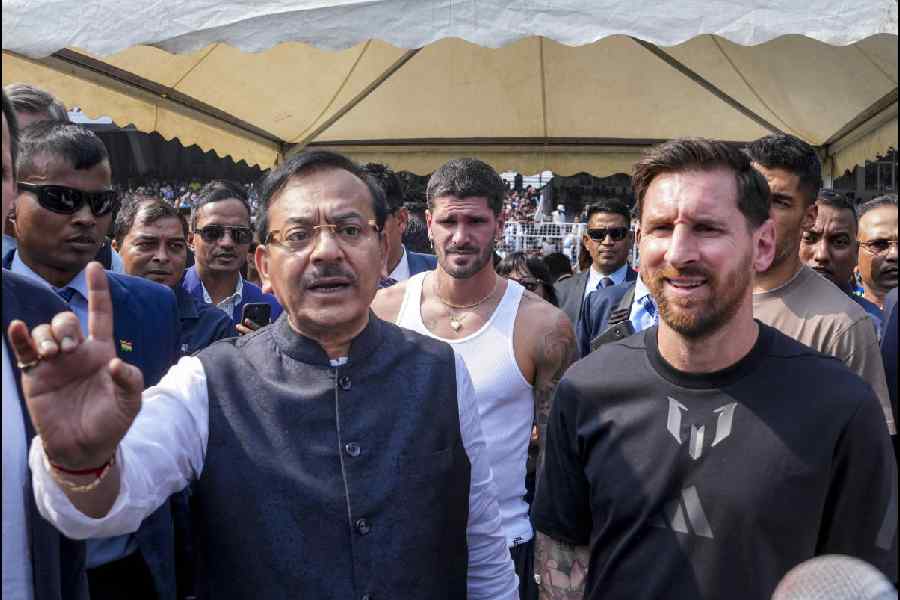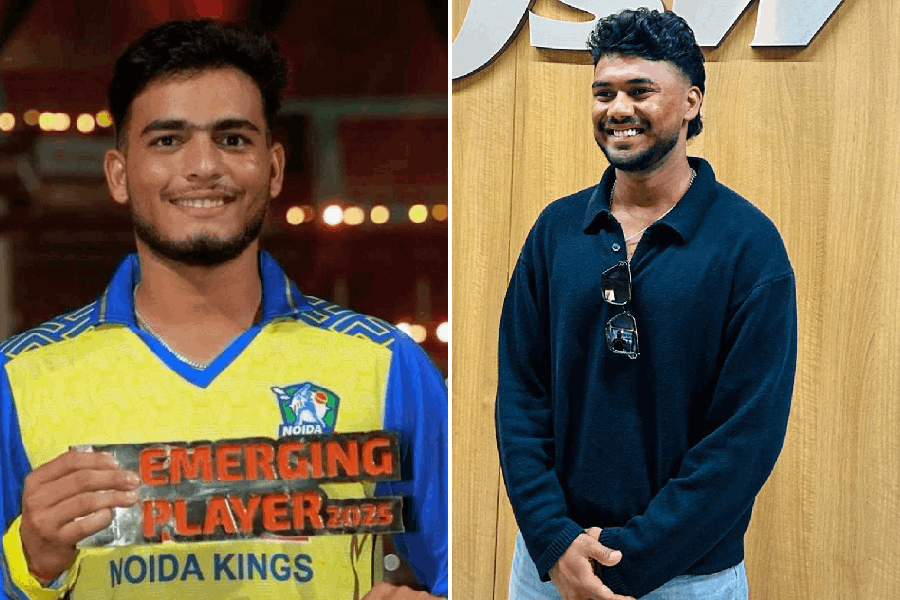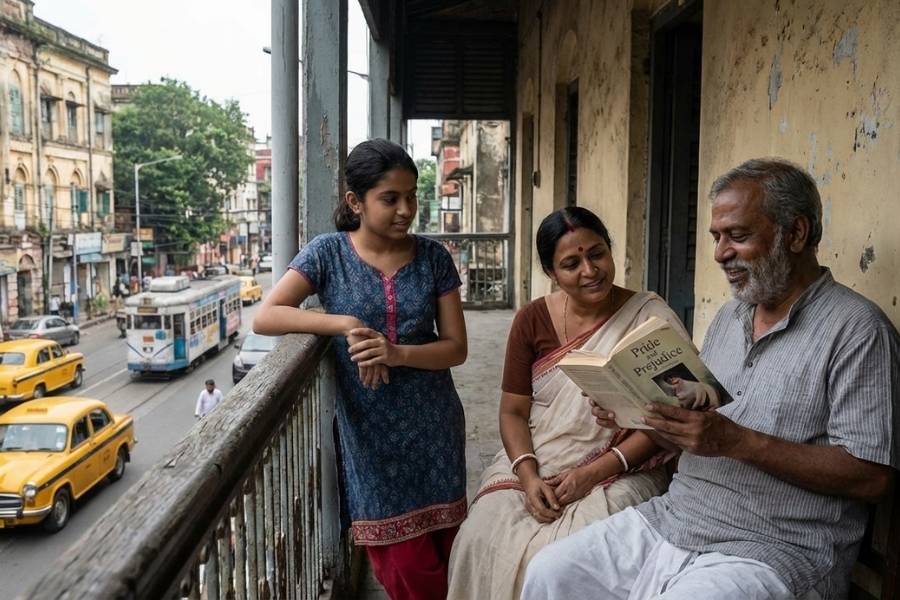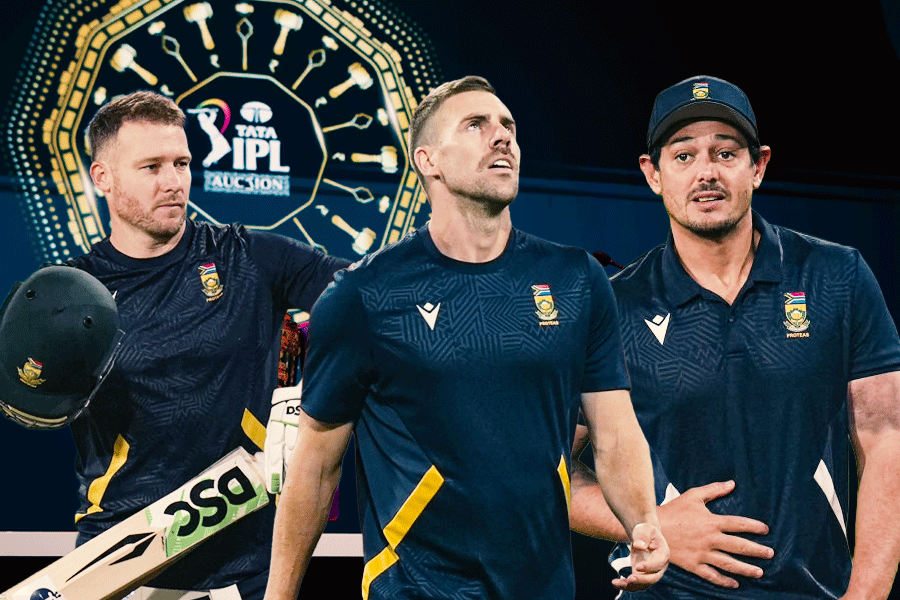.jpg)
Last February a group of students congregated at the foot of the life-size statue of Swami Vivekananda in Delhi University's Arts Faculty complex. The black sculpture of the 19th century sage-philosopher is modelled on the famed Chicago pose - turban on head, buttoned up robe, sash around waist, head at an angle, square jaw and bulky frame creating an aura of confidence and composure, folded arms suggest a stolid defence, and making benign the overall effect, a pair of soulful eyes. One T.J. Desai, who was associated with the establishment of the early Vedanta circle in London and had attended Vivekananda's lectures, had commented - he looked more prince and less sadhu.
That day at Delhi Univer-sity (DU), slogans such as "Hindustan me rehna hoga, Vande Mataram kehna hoga" and "Bharat ke gaddaron ko, goli maaro saalon ko" filled the air. The next thing you knew, a scuffle had broken out between the ABVP crowd and the Left-wing students' organisation of DU's Ramjas College. The issue: JNU student leader Umar Khalid, a virulent opponent of the RSS-BJP led Right-wing, had been invited to speak at a literary event in the college.
The invitation to Khalid was cancelled, but a year hence, ABVP's national media convener Saket Bahuguna tells The Telegraph, "Vivekananda stood for unity and integrity of the country. We were protesting against someone who believes in breaking up India."
A comparison of the original 1893 Thomas Harrison photograph of Vivekananda taken at Chicago and DU's stone rendition reveals a difference. The eyes of the statue are narrowed, the brows a wee bit more angular. Is the mouth also a bit too firm? Is this Vivekananda more warrior than sadhu?
Icons are supposed to help beam onto the masses a particular ideology, emblazon in people's minds the dominant thought of the times, also checkmate icons of the previous regime. Ever since it assumed power in 2014, the BJP government has been working to create its own iconography.
But not many Indians are aware what V.D. Savarkar or Deendayal Upadhyaya or M.S. Golwalkar look like. Sardar Vallabhbhai Patel is not invisible, but not visible enough. After Ram perhaps, Vivekananda is the only other icon in the BJP-RSS quiver with an already accepted visual identity and a recall value.
.jpg)
Besides, there is that ready-made saffron hue; the famed Chicago story - the 1893 Parliament of the World's Religions and a dashing Hindu rep; and, of course, the echo of a name. In 2016, BJP's national general secretary Ram Madhav said, "Narendras tend to be courageous," drawing a parallel between the PM Narendra Modi and Vivekananda, who was born Narendranath Dutta.
As professor of Religion and Asian Studies at Pennsylvania's Elizabethtown College, Jeffery D. Long, puts it, "It is convenient for the Right-wingers to invoke Vivekananda because he is universally accepted. It is easier to convince people about your agenda or ideology if you cite him in favour of the point of view you propagate."
Not one to miss an opportunity that might gain traction, yield more votes, the BJP does just that. Today, Vivekananda's face powers countless campaigns - Swachh Bharat, women's empowerment... References to him abound in the PM's speeches - be it at the US Congress or in his radio show, Mann Ki Baat. Three years ago, a webpage was launched by the Centre to mark the 152nd Birth Anniversary of Vivekananda on January 12, which is also celebrated as National Youth Day. Some will recall how way back in 2012, Modi did a "Vivekananda Yuva Vikas Yatra" before the Gujarat Assembly elections, wherein a statue of Vivekananda was rolled out atop a chariot. In 2014, a comic book titled Bal Narendra was released - it also features stories of the "fearless" young Narendra reading books on Vivekananda.
In truth, though, it was Rajiv Gandhi who declared Vivekananda's birthday as National Youth Day in 1984; there are extensive writings on him by Jawaharlal Nehru; Mahatma Gandhi spoke extensively about him, even visited Belur Math, the headquarters of the Ramakrishna Mission. But all of these are conscious and deliberate omissions by Right-wingers who have decided to foist Vivekananda on the general Indian consciousness as the flagbearer of Hindutva ideology.
And that's problematic because?
Because they are half-truths, extrapolations. Because they are merely imposing their brand of Hindutva onto him.
The appropriation of Vivekananda did not happen overnight. The RSS's first mega Vivekananda project was the construction of the Vivekananda Rock Memorial in 1970 at Kanyakumari. It was the initiative of RSS heavyweight Eknath Ranade. The Vivekananda statue in DU was set up in 1978, when BJP leader Vijay Goel was the Delhi University Students' Union president. In 1993, during the centenary celebrations for Vivekananda's Chicago speech, Vishwa Hindu Parishad leader Ashok Singhal had said that the demolition of Babri Masjid would be recorded in "letters of gold" and Hindus would not rest till the Ram Mandir was built.
This yolking of man, agenda and event was grossly unfair, but there it was. In 2009, a Right-wing think tank, Vivekananda International Foundation, was established in Delhi under the aegis of the charitable organisation, Vivekananda Kendra, run by Ranade. Among its lead cast used to be Ajit Doval, currently the national security adviser.
A pose, a speech, a robe, a name, some quotes - it is possible to reduce Vivekananda to tropes, except that the man was much more. The evidence is in his upbringing and education. The evidence lies in his written and spoken word.
According to a bio-sketch in the Dictionary of National Biography, 1974, Vivekananda's home atmosphere was a blend of modernism and orthodoxy. His brother, Bhupendranath, has written about how their father "was a respecter of the Bible and the Diwan-i-Hafiz", for which he was criticised by many. He writes, "If it be a sin to be a student of comparative religion and to respect all cults, then Biswanath [Vivekananda's father] had undoubtedly committed that sin." Their mother, Bhuvaneswari Devi, who made an abiding impression on Vivekananda, was a devout Hindu.
So far as formal education goes, Narendranath did BA from Scottish Church College, and thereafter studied Law - he did not take the final examinations, though. He was widely read, hugely invested in social reforms and knowledgeable about the Vedas. "He was a reformer and criticised prevalent practices of Hindu religion just as he might be critical of Christian or Islamic religious practices," says historian Mridula Mukherjee.
Did Vivekananda put a premium on Hindusim? Yes, he did. According to Jeffery Long, Vivekananda was convinced that if Hindus could awaken to their past greatness, they could live with dignity and pride in their traditions. But Long also makes it clear that this did not translate into hatred for other traditions.
Vivekananda did say of Islam that it was a religion that had "shed so much blood" and "been cruel to other men", but he also said this - "For our own motherland a junction of the two great systems, Hinduism and Islam - Vedanta brain and Islam body - is the only hope. I see in my mind's eye the future perfect India rising out of this..."
And when Vivekananda spoke about Hinduism, he did not use the word "Hindutva" - that was a coinage of Savarkar. "Vivekananda warned against the forces of sectarianism and bigotry and invoked the Bhagavad Gita to emphasise the message of universal acceptance. But not many understand it," says Veena Howard, a trustee member of the Parliament of the World's Religions, a global interfaith body.
In recent times, Hindu groups have been using Vivekananda to force-feed their neo-nationalism. The way it works is, they proceed by negation. They define things that are considered anti-national, such as denouncing Western culture, beef eating... And every time, they push down people's throats a theory, they invoke Vivekananda. "Vivekananda realised that Western culture was not good for him." (He actually spoke against Western Imperialism.) "Vivekananda said eating beef is disgusting." (He actually conceded that Brahmins at some point ate beef; he also said it was allowable for people who work hard, but not for those who are going to be bhaktas.)
Long points out that the word "nationalism" is used only once in Swami Vivekananda's Complete Works, and that too in reference to European nationalism; but there are a number of references to "patriotism" - not surprising given the immediate context was the freedom movement.
In Bengal, the BJP has turned Vivekananda into a people bait. In 2013, Modi meditated in Vivekananda's room in Belur Math. In 2017, BJP president Amit Shah went to Vivekananda's north Calcutta house to pay tribute. The RSS organised a film festival in Calcutta titled "Manush Chai" to promote "nationalism and Indian ethos". The posters had on them Vivekananda's image and a famous quote - "Give me hundred energetic young men and I shall transform India." The saffron forces are actually body-shopping.
Of course, Bengal state general secretary of the RSS, Jisnu Basu, says, "Our mission is man-making. We want the youth to make this country prosperous just as Vivekananda wanted. That was the essence of the festival too."
And while there are murmurs of protest, there has been no concentrated effort, no strong voice objecting to this misappropriation of Vivekananda. Internationally, however, there have been stray efforts to resuscitate his teachings of acceptance and inclusiveness.
In 2013, on the occasion of his 150th birth anniversary, Australian playwright and director Alex Broun's play, Oneness - Voice without form, was staged at the Sydney Opera House. He tells The Telegraph over email, "The play carried the message of Vedanta that all religions in essence are same."
Actors from nine countries including Sri Lanka and Palestine came together to perform. Calcutta-based actor-singer Shaheb Chattopadhyay played the lead. He speaks about how Vivekananda's idea of oneness was reflected in the play as it had actors of different nationalities and faiths "coming under one roof for one purpose". He adds, "Each one of us brought in his idea of love, peace and acceptance."
Chattopadhyay makes another observation. He tells us how the play was staged in Australia and Dubai, but did not find any sponsors in Calcutta. He says, "It is so unfortunate that nobody is keen to sponsor a play on Vivekananda in his birthplace. That clearly reflects the apathy of the people."
Indeed, it is one thing for the forces of Hindutva to misappropriate Vivekananda, quite another thing to let them do so.
Or, eventually, for them to be able to.

.jpg)
